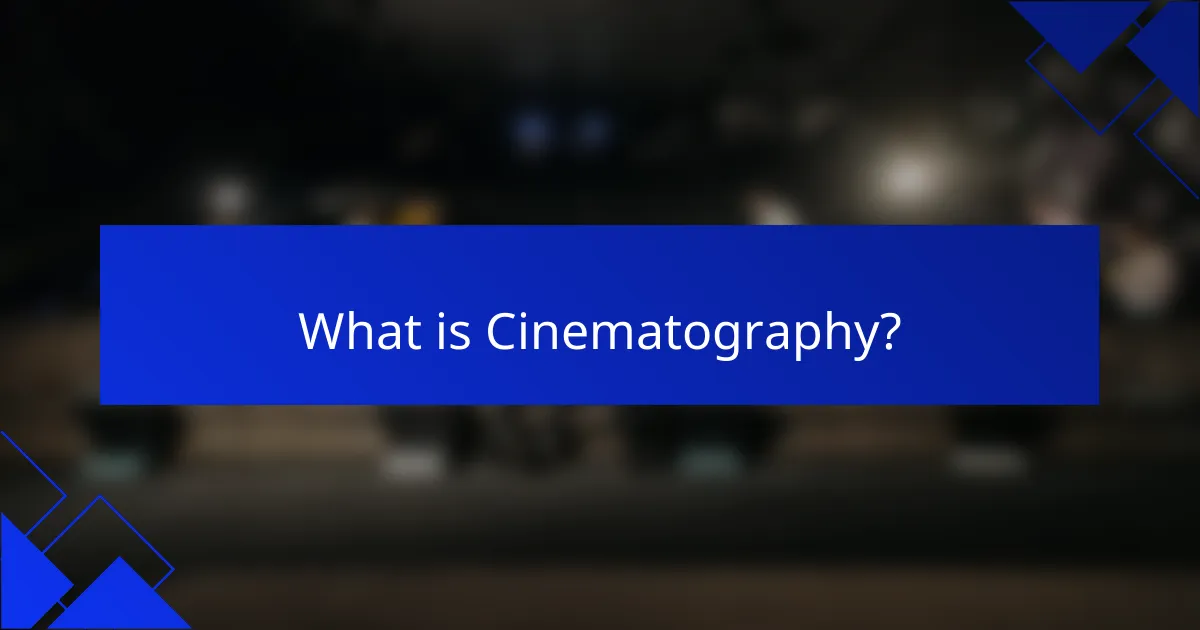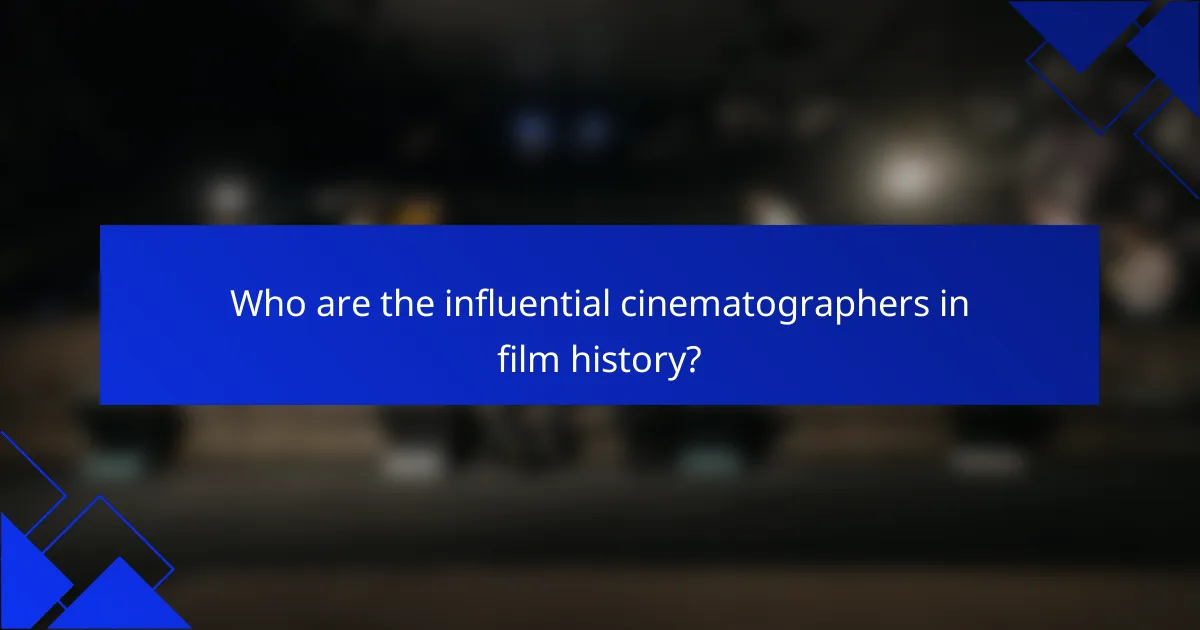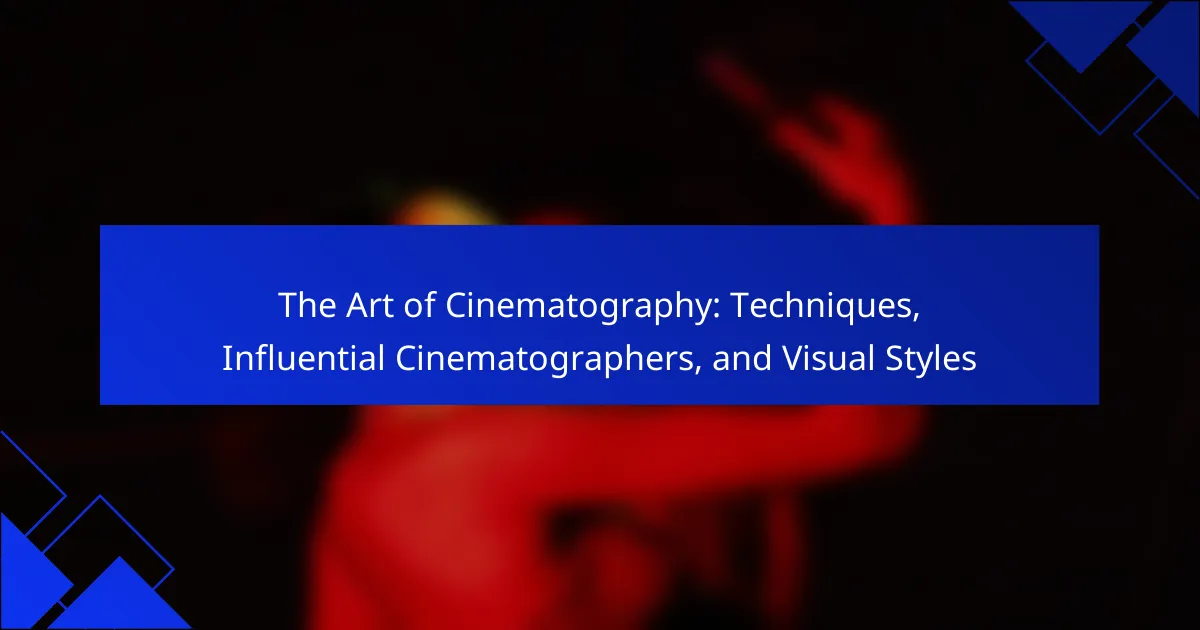
What is Cinematography?
Cinematography is the art and technique of capturing visual images for film and television. It involves the use of cameras, lighting, and composition to create a specific visual style. Cinematographers, also known as directors of photography, make critical decisions about shot composition, camera movement, and lighting. Their work influences the mood and storytelling of a film. The history of cinematography dates back to the late 19th century with the invention of motion picture cameras. Notable techniques include framing, depth of field, and color grading. These elements work together to enhance the narrative and emotional impact of a visual story.
How does cinematography influence visual storytelling?
Cinematography significantly influences visual storytelling by shaping how a narrative is perceived. It involves the art of capturing images through camera work, lighting, and composition. Effective cinematography can evoke emotions and set the tone of a scene. For instance, low-key lighting creates tension, while bright lighting conveys happiness. Camera angles and movements also guide audience focus and interpretation. Close-ups highlight character emotions, while wide shots establish context. Historical examples include the use of deep focus in “Citizen Kane,” which enhances narrative depth. Overall, cinematography is essential in conveying themes and enhancing viewer engagement.
What are the fundamental principles of cinematography?
The fundamental principles of cinematography include composition, lighting, camera movement, and color. Composition refers to the arrangement of visual elements in a frame. It guides the viewer’s eye and conveys meaning. Lighting shapes the mood and atmosphere of a scene. It can highlight subjects or create shadows for depth. Camera movement involves techniques like pans, tilts, and tracking shots. These movements enhance storytelling by adding dynamism. Color influences the emotional tone of a film. Different hues evoke specific feelings and reactions. Together, these principles create a cohesive visual narrative, essential for effective cinematography.
How does lighting affect the mood of a scene?
Lighting significantly affects the mood of a scene. Different lighting techniques can evoke various emotions. Bright lighting often creates a cheerful or energetic atmosphere. Conversely, dim lighting can establish tension or sadness. The color temperature of light also plays a crucial role. Warm tones can evoke comfort, while cool tones may suggest isolation. High contrast lighting can create drama and suspense. Soft lighting tends to produce a more romantic or serene feeling. Studies have shown that lighting influences viewer perception and emotional response. For instance, a study published in the Journal of Experimental Psychology found that lighting conditions can alter mood states in film audiences.
What are the key techniques used in cinematography?
Key techniques used in cinematography include composition, lighting, camera movement, and lens choice. Composition involves framing shots to create visual interest and convey meaning. Lighting shapes the mood and atmosphere of a scene, influencing how viewers perceive it. Camera movement, such as pans and tilts, adds dynamism to storytelling. Lens choice affects depth of field and perspective, impacting how subjects are viewed. These techniques are essential for effective visual storytelling in film.
How do camera angles impact viewer perception?
Camera angles significantly influence viewer perception by altering how subjects are interpreted. High angles can make subjects appear vulnerable or insignificant. Conversely, low angles can convey power and dominance. Eye-level shots tend to create a neutral perspective, fostering a sense of realism. Dutch angles can evoke unease or tension. Each angle shapes emotional responses and narrative understanding. For instance, a study by R. G. D. and A. M. in the Journal of Visual Communication found that camera angles affect audience empathy and engagement. This demonstrates the profound impact of camera angles on storytelling in cinematography.
What role does composition play in framing a shot?
Composition is essential in framing a shot as it determines how visual elements are arranged. It influences the viewer’s focus and emotional response. Effective composition guides the eye to key subjects within the frame. Techniques such as the rule of thirds help create balance and interest. Proper composition can enhance storytelling by emphasizing themes and moods. Studies show that well-composed shots are more engaging and memorable. For instance, a study by the University of Southern California highlighted that viewers preferred compositions that followed established guidelines. This indicates the significant impact of composition on audience perception.
Why is understanding visual styles important in cinematography?
Understanding visual styles is crucial in cinematography because it shapes the audience’s perception and emotional response. Visual styles encompass lighting, color palettes, and composition. These elements work together to convey mood and tone. For example, a dark, desaturated color scheme can evoke feelings of despair. In contrast, bright, vibrant colors can create a sense of joy or excitement. Cinematographers use visual styles to tell stories effectively. A well-defined visual style can become a signature of a filmmaker, enhancing their brand. Historical examples include the distinct visual styles of directors like Wes Anderson or Quentin Tarantino. Their unique approaches have significantly influenced audience expectations and cinematic trends. Understanding these styles allows cinematographers to innovate and push creative boundaries.
What are the different visual styles in film?
Different visual styles in film include realism, expressionism, and surrealism. Realism aims to depict life as it is, often using natural lighting and authentic settings. Expressionism emphasizes emotional experience over physical reality, utilizing dramatic lighting and distorted sets. Surrealism blends dream-like imagery with reality, creating a sense of the bizarre. Other styles include noir, characterized by high contrast and shadow, and minimalism, focusing on simplicity and subtlety. Each style influences the film’s mood and audience perception.
How do visual styles convey themes and emotions?
Visual styles convey themes and emotions through the use of color, composition, and lighting. Color can evoke specific feelings; for example, warm colors often create a sense of warmth or happiness. Cool colors, on the other hand, can invoke calmness or sadness. Composition influences how viewers perceive relationships between characters and their environments. For instance, tight framing can create feelings of intimacy or tension. Lighting plays a crucial role in setting the mood; high contrast can suggest conflict, while soft lighting can indicate tranquility. Historical films often use sepia tones to evoke nostalgia. Each visual choice reinforces the narrative, guiding audience emotions and responses effectively.

Who are the influential cinematographers in film history?
Influential cinematographers in film history include Roger Deakins, Gordon Willis, and Vittorio Storaro. Roger Deakins is known for his work on films like “Skyfall” and “1917.” His use of natural light and composition has set new standards in cinematography. Gordon Willis, often referred to as the “Prince of Darkness,” is celebrated for his work on “The Godfather” series. His mastery of shadow and light created a unique visual style. Vittorio Storaro is recognized for his collaboration with director Bernardo Bertolucci on “The Last Emperor.” His innovative use of color and light has influenced many filmmakers. These cinematographers have significantly shaped the visual language of cinema through their distinctive techniques and styles.
What contributions have notable cinematographers made to the art?
Notable cinematographers have significantly advanced the art of filmmaking through innovative techniques and visual storytelling. They have introduced unique lighting styles that enhance mood and atmosphere. Their mastery of camera movement has transformed how stories are visually expressed. Iconic works by cinematographers like Roger Deakins and Emmanuel Lubezki showcase groundbreaking compositions and depth of field. Deakins’ work on “Skyfall” utilized natural light to create a realistic yet dramatic aesthetic. Lubezki’s use of long takes in “Birdman” created an immersive experience for viewers. These contributions have set new standards for visual narrative in cinema. Their influence continues to inspire new generations of filmmakers and cinematographers.
How did Roger Deakins redefine modern cinematography?
Roger Deakins redefined modern cinematography through innovative techniques and a distinctive visual style. He emphasizes natural lighting and composition to create immersive atmospheres. Deakins’ work on films like “Skyfall” and “1917” showcases his mastery of visual storytelling. He often uses long takes and fluid camera movements, enhancing narrative engagement. His collaboration with directors like the Coen brothers and Sam Mendes has produced iconic imagery. Deakins’ approach influences contemporary cinematographers, setting new standards in the industry. His accolades, including multiple Academy Awards, validate his impact on the craft.
What techniques did Emmanuel Lubezki popularize in his films?
Emmanuel Lubezki popularized several key cinematographic techniques in his films. He is known for his use of natural lighting. This technique enhances the realism and emotional depth of scenes. Lubezki often employs long takes. These extended shots create a fluid narrative and immersive experience. He frequently utilizes wide-angle lenses. This approach captures expansive landscapes and intricate details. Another technique is the use of handheld camera work. This adds a sense of immediacy and intimacy to the storytelling. Lubezki’s collaboration with directors like Alfonso Cuarón and Alejandro Iñárritu showcases these techniques. His work in films like “Gravity” and “Birdman” exemplifies his innovative approach to cinematography.
What are some iconic works by influential cinematographers?
Some iconic works by influential cinematographers include “Blade Runner” by Roger Deakins. This film is renowned for its atmospheric lighting and visual storytelling. “The Godfather” features cinematography by Gordon Willis, known for its rich shadows and color palettes. Emmanuel Lubezki’s work in “The Revenant” showcases natural lighting and long takes. “Schindler’s List” by Janusz Kamiński is notable for its stark contrasts and emotional depth. Vittorio Storaro’s cinematography in “Apocalypse Now” is acclaimed for its use of color and composition. Each of these works demonstrates the unique vision and techniques of their respective cinematographers.
How did Gordon Willis shape the visual language of the 1970s?
Gordon Willis significantly shaped the visual language of the 1970s through his innovative cinematography techniques. He is renowned for his work on films like “The Godfather” and “Annie Hall.” Willis utilized low lighting and deep focus to create a distinct atmosphere. His approach emphasized mood and character over traditional lighting techniques. He often employed shadows to enhance emotional depth. This style influenced a generation of filmmakers and cinematographers. Willis’s techniques became a hallmark of 1970s cinema. His work is frequently cited in discussions of visual storytelling and cinematographic innovation.
What impact did Vittorio Storaro have on color grading?
Vittorio Storaro significantly influenced color grading in cinematography. He pioneered the use of color to enhance narrative depth. Storaro’s approach involved the psychological use of color to evoke emotions. He integrated color theory into his work, impacting films like “Apocalypse Now” and “The Last Emperor.” His techniques emphasized the relationship between light and color. Storaro’s work led to a greater understanding of color palettes in visual storytelling. He also contributed to the development of digital color grading techniques. His legacy continues to shape modern cinematography practices.

What are the emerging trends in cinematography today?
Emerging trends in cinematography today include the use of advanced digital cameras and drones. These technologies enhance visual storytelling and provide unique perspectives. Virtual reality (VR) and augmented reality (AR) are also gaining traction. They allow for immersive viewing experiences that engage audiences in new ways. Additionally, the trend of shooting in high dynamic range (HDR) is becoming more prevalent. HDR provides greater contrast and color depth, enriching the visual experience. Another trend is the increased use of natural lighting. Filmmakers are opting for authenticity and realism in their visuals. Finally, the rise of remote collaboration tools is changing how cinematographers work. This allows for more flexible production processes, especially in a globalized industry.
How is technology shaping the future of cinematography?
Technology is significantly shaping the future of cinematography through advancements in camera equipment, software, and techniques. High-definition cameras enable filmmakers to capture stunning visuals with greater clarity. Innovations like 4K and 8K resolution are becoming standard, enhancing the viewing experience. Drones and gimbals provide new ways to achieve dynamic shots and smooth movements. Virtual reality (VR) and augmented reality (AR) are expanding storytelling possibilities, allowing immersive experiences. Artificial intelligence (AI) is optimizing editing processes, making them faster and more efficient. These technological advancements are transforming how stories are told visually in cinema.
What role do digital cameras play in contemporary filmmaking?
Digital cameras are essential tools in contemporary filmmaking. They enable filmmakers to capture high-quality images with greater flexibility and efficiency. Digital cameras allow for immediate playback, facilitating quick adjustments during shoots. They also support various resolutions, including 4K and 8K, enhancing visual detail. The use of digital cameras reduces costs associated with film stock and processing. Additionally, they integrate advanced features like high dynamic range and low-light performance. Filmmakers can experiment with different styles and techniques more easily. Overall, digital cameras have transformed the filmmaking process by increasing accessibility and creative possibilities.
How are drone shots changing cinematographic techniques?
Drone shots are revolutionizing cinematographic techniques by enabling dynamic aerial perspectives. They allow filmmakers to capture sweeping landscapes and intricate movements that were previously difficult or costly to achieve. Traditional methods, such as cranes or helicopters, often limited the scope and flexibility of shots. Drones offer a more accessible and versatile alternative for achieving high-altitude footage.
This technology facilitates real-time adjustments during filming, enhancing creative control. It also reduces production costs and time, making aerial cinematography more feasible for independent filmmakers. Research indicates that films utilizing drone technology have seen increased audience engagement due to their visually striking content. The integration of drone shots into cinematography is reshaping visual storytelling by expanding the possibilities of scene composition and movement.
What skills are essential for aspiring cinematographers?
Aspiring cinematographers need a combination of technical and creative skills. First, they should understand camera operation and settings. Knowledge of lighting techniques is also crucial. This includes how to manipulate natural and artificial light. Composition skills help in framing shots effectively. An understanding of color theory enhances visual storytelling. Familiarity with editing software is beneficial for post-production work. Additionally, strong communication skills are essential for collaborating with directors and crew. These skills collectively enable cinematographers to create compelling visual narratives.
How can one develop a unique visual style in cinematography?
To develop a unique visual style in cinematography, one must focus on several key aspects. First, understanding the fundamentals of lighting is essential. Different lighting techniques can evoke specific moods and emotions. Second, experimenting with camera angles and movements can create distinctive perspectives. Utilizing unconventional angles can set a film apart visually. Third, selecting a color palette is crucial. Color choices can significantly influence the tone of the narrative. Fourth, incorporating texture through set design and costumes adds depth to visuals. Fifth, studying the works of influential cinematographers can provide inspiration. Notable examples include Roger Deakins and Emmanuel Lubezki, who have distinct styles. Lastly, practice and feedback are vital for refinement. Regularly shooting and analyzing one’s work leads to growth and a clearer visual identity.
What are the best practices for collaborating with directors?
Effective collaboration with directors involves clear communication and understanding their vision. Establish a shared creative vision early in the project. This ensures that both the cinematographer and director are aligned on goals. Regular meetings can help maintain this alignment throughout production. Actively listen to the director’s ideas and feedback. This fosters a collaborative atmosphere and encourages creative input. Utilize visual references to discuss concepts. This aids in conveying ideas more effectively. Be adaptable and open to changes during the shooting process. Film production often requires flexibility to achieve the best results. Finally, maintain professionalism and respect throughout the collaboration. This builds a strong working relationship and enhances the overall creative process.
What tips can enhance cinematographic skills?
Practice regularly to enhance cinematographic skills. Regular practice helps develop technical proficiency. Familiarize yourself with camera settings and lighting techniques. Experiment with different angles and compositions. Study the work of influential cinematographers for inspiration. Analyze their techniques and apply them in your projects. Seek feedback from peers to identify areas for improvement. Attend workshops or online courses to learn new skills and techniques.
How can practice and experimentation improve technique?
Practice and experimentation enhance technique by allowing individuals to refine their skills through repetition and innovation. Regular practice builds muscle memory, making movements more fluid and automatic. Experimentation encourages exploration of different methods and styles, fostering creativity. This combination leads to a deeper understanding of tools and techniques. Studies in skill acquisition show that deliberate practice significantly improves performance over time. For example, a study by Ericsson et al. (1993) demonstrated that expert performers engage in structured practice to achieve mastery. Therefore, consistent practice and innovative experimentation are essential for mastering cinematographic techniques.
What resources are available for learning cinematography?
Online courses are available for learning cinematography. Platforms like MasterClass and Udemy offer courses taught by industry professionals. Books such as “Cinematography: Theory and Practice” provide foundational knowledge. Film schools like the American Film Institute offer comprehensive programs. YouTube channels dedicated to cinematography share practical tips and tutorials. Workshops and seminars often feature hands-on training. Networking with professionals in the field can also provide valuable insights. These resources collectively enhance understanding and skills in cinematography.
The main entity of the article is cinematography, defined as the art and technique of capturing visual images for film and television. The article explores various aspects of cinematography, including its influence on visual storytelling, fundamental principles such as composition and lighting, and key techniques used by cinematographers. It highlights the contributions of influential cinematographers like Roger Deakins and Emmanuel Lubezki, as well as emerging trends and technological advancements shaping the future of the field. Additionally, the article discusses the importance of developing a unique visual style and best practices for collaboration with directors to enhance cinematographic skills.
